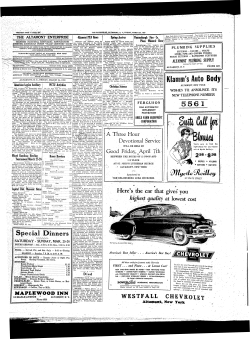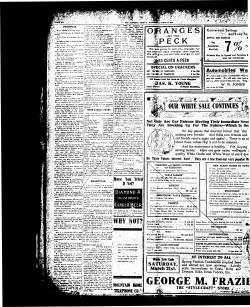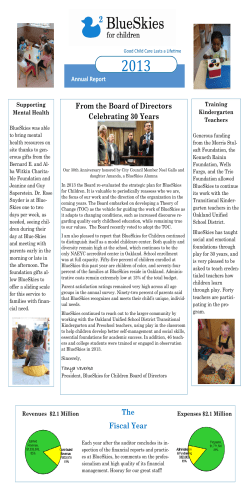
NHS Board Meeting Wednesday 28 March 2012
NHS Board Meeting 28 March 2012 Paper 15 NHS Board Meeting Wednesday 28 March 2012 Subject Minutes of the Clinical Governance Committee Purpose To report to the Board Recommendation To receive the draft Clinical Governance Committee minutes of 29 February 2012 1. Background 1.1 Committees of the Board should submit approved and draft minutes to the Board. 2. Current situation 2.1 Attached are the draft minutes of 29 February 2012. 3. Conclusion 3.1 The Board is asked to receive the minutes. Dr David Price Chair – Clinical Governance Committee 7 March 2012 1 of 16 Ayr Hospital Ayr KA6 6DX Telephone 01292 614510 Clinical Governance Committee Wednesday 29th February 2012 at 9am Board Room, Ayr Hospital Present: Dr David Price, Non Executive Board Member (Chair) Mrs Gillian Watson, Non Executive Board Member Mr David O‟Neill, Non Executive Board Member Mrs Kirsty Darwent, Non Executive Board Member Mrs Janet McKay, Area Clinical Forum In attendance: Prof Robert Masterton, Executive Medical Director Mrs Fiona McQueen, Executive Nurse Director Prof Craig White, Assistant Director Mrs Diane Murray, Assistant Director Dr Grant McHattie, Associate Medical Director (For item 1.1) Dr John Taylor, Associate Medical Director (For items 1.2 and 1.3) Mr Eddie Docherty, Nurse Consultant(For item 7.2) Mr Andrew Moore, Assistant Director for Nursing (PF&PI) (For item 7.3) Audrey Christie, PA to Assistant Director and AMD (minutes) 1. PROPOSED NEW MODEL FOR THE INVESTIGATION AND RESOLUTION OF PERFORMANCE ISSUES IN PRIMARY CARE Dr Grant McHattie, Associate Medical Director, Primary Care Development was in attendance to present the proposed new model for the investigation and resolution of performance issues in primary care. Independent contractors in primary care provide services to NHS Ayrshire & Arran on a contractual basis. The contracts are nationally defined and cover General Medical Services, General Dental Services, Pharmaceutical Services and Optometric Services. The contractors are not employed by NHS Ayrshire & Arran and, as such, Human Resource policies for performance and discipline do not apply. There is a need to establish a transparent, robust and formal structure to identify, investigate and resolve performance issues in Primary Care. In January 2010, the National Clinical Assessment Service (NCAS) and the National Patient Safety Agency (NPSA) published two documents – “Handling performance concerns in primary care” and “How to conduct a local performance investigation”. These two documents effectively set out a gold standard framework for policies and procedures in this area. At the moment when performance issues within the independent contractor community are identified by or are reported to NHS Ayrshire & Arran, these are addressed at the Primary Care Delivery Group. This group comprises of the Director of Primary Care and Mental Health Services, the Associate Medical Director for Primary Care Development and the Head of Primary Care. The group 2 of 16 invites other individuals with relevant expertise to attend meetings when their advice is required to address a performance issue. These would include the Dental Advisor, the Optometric Advisor or the Pharmaceutical Advisor. The group currently investigates or where appropriate asks others to undertake investigation and then decides upon a course of action for each individual event. It is proposed that NHS Ayrshire & Arran should move to implement the recommendations of the NCAS reports. This scheme relates only to registered health care professionals providing services within primary care. In doing so, the current Primary Care Delivery Group should be restructured as a screening group to decide upon the need to instigate an investigation into performance issues. Membership of this group would be: The Community Health Partnership (CHP) Clinical Leads; The Dental Practice Advisor The Optometry Advisor The Lead Pharmacist – Public Health and Community; and The Head of Primary Care In addition the relevant professional advisor would be in attendance to provide expert advice. It is also proposed that NHS Ayrshire & Arran should establish a Primary Care Decision Making Group (PCDMG). The PCDMG would have no investigative function but would hear performance issues brought to it by the Primary Care Delivery Group. The PCDMG would consist of: A Non Executive Director of NHS Ayrshire & Arran (Chair) The Director of Primary Care and Mental Health Services The Associate Nurse Director for Primary Care Development The Associate Medical Director for Primary Care Development The Chair of the relevant Area Professional Committee In the event that the Chair of the Area Dental Professional Committee is not a General Dental Practitioner then the Committee will appoint a suitable representative. In the event the PCDMG felt that further investigation was appropriate, it would establish an appropriate panel of experts to consider each performance issue within each directorate. Each of these Professional Assessment and Support Groups (PASG) would undertake the investigation and make its report and recommendations available to the PCDMG who would endorse and take action on the recommendations from the PASG. The Clinical Governance Committee were concerned that there would be a lack of external objectivity. Prof Masterton informed that Dr McHattie would be sitting on the Group but would be representing him and will report directly to him on a regular basis. It was agreed that Prof Craig White would also become a member of the PCDMG. Mrs Watson asked what the cost of clinical representation on a PASG would be and whether a cost benefit analysis could be carried out. Dr McHattie advised 3 of 16 that clinical representation on the Dental, Optometry and Pharmacy PASG is not currently routinely used as part of the investigative process and would therefore require an additional resource. Based on the number of issues experienced within each professional group in the last 12 months, this additional coat would be in the region of £28,700. It would be very difficult to calculate what is being prevented and this is our statutory duty to protect the public. Dr McHattie advised that Union representation has been removed from the membership of the PASG for General Medical Services. The Clinical Governance Committee was happy to approve the document. 2. HEALTHCARE ASSOCIATED INFECTION Mr Robert Wilson, Infection Control Manager and Dr John Taylor, Associate Medical Director Mental Health Services were in attendance to present on Healthcare Associated Infection. Since April 2005 there has been a 6.9% year on year reduction in the Scottish SAB rate. This has been driven almost exclusively by MRSA. In that time MSSA reduction has been non-significant. The last verified NHS Ayrshire & Arran quarterly rate for period ending September 2011 was 0.33. The Scottish average for the same period was 0.3. The local pattern is reflective of the national picture. MRSA as a proportion of all SABs have fallen from 25% to 11%. The differences in epidemiology are poorly understood. Areas of intervention for 2012 – 13 are: Focus remains on vascular access related SABs Multidisciplinary Renal SAB Working Group established to review all SAB related issues Renal and Oncology Clinical Teams, supported by Infection Control Team, to undertake review of all SAB case to ensure learning and promote changes in practice PVC insertion bundle spread throughout organisation by Infection Control Team and Clinical Improvement Unit Hickman and Peripherally Inserted Central Catheter (PICC) Line Training and Competency programme being developed and rolled out to Crosshouse and Ayr Hospital Blood culture Learn-pro package introduced Blood culture Care Bundle to be incorporated into Sepsis 6 work programme Enhanced surveillance of all community related SABs to identify potential areas of intervention Liaison with Health Protection Scotland re community Interventions All antibiotics increase the risk of developing CDI. The four groups considered to present the highest risk are known collectively as them “4Cs”. These are: Cephalosporins Co-amoxiclav Fluroquinolones (Ciprofloxacin) Clindamycin 4 of 16 Actions taken to reduce the increased risk of developing CDI are: Revised Surgical Prophylaxis Policy Antibiotic Bundle Project in Care of the Elderly using Improvement Methodology Promote compliance with prescribing policies Engage with clinical teams to agree further reduction in policy indications for 4C antibiotics Additional AMT resource Further work that is being undertaken is: Sepsis 6 Clinically led by Mr Eddie Docherty, Nurse Consultant It was agreed that a proposal to implement root cause analysis will commence on all SABs. An HAI action plan will be tabled at the next Committee meeting. RW It was agreed that process measures to support the „big dot‟ outcome measures for infection rates would be developed and reported to CCIB. 3. DM MENTAL HEALTH SERVICES CLINICAL GOVERNANCE ANNUAL REPORT 2010 / 11 Dr John Taylor, Associate Medical Director for Mental Health Services (MHS) was in attendance. This is the third MHS Clinical Governance annual report which provides a brief overview of the activities, achievements and outcomes relating to healthcare quality, clinical governance and risk management within the Mental Health Directorate during 2010 – 2011. The report provides assurance to the Clinical Governance Committee that all elements of healthcare quality, clinical governance and risk management within the MHS Directorate are operating effectively and complying with local objectives and national guidelines. The Committee was concerned with the last sentence in the last paragraph on page 9 which read “The reason for this decline is that there were further high risks added to the register however no action plans were created”. Dr Taylor advised that he would investigate this and will report back with an update on why no action plans were created and provide assurance that action plans would be in place for these risks. Mrs Darwent asked how it was decided what information should be included into the report as she was aware there was an issue to access psychology but this was not reported. It was agreed that Dr Taylor would discuss this with the Mental Health Governance & Development Group and report the access to adult psychology services and what impact this has and will report back to the next Clinical Governance Committee meeting. JT JT The committee stated that it expected that access data should be reported through Health and Performance Governance Committee, with specific quality and safety data that are linked to these being reflected in the Clinical Governance Committee report. 5 of 16 Mrs Watson commented that the current annual reporting cycle was not helpful(ie this one is almost 1 year out of date), and that the structure of each annual report differs. It was agreed that annual reports for Integrated Care and Emergency Services, Integrated Care and Partner Services and Mental Health Services would all be presented at the June Clinical Governance Committee meeting and Prof Masterton advised that he would be happy to prepare the agenda on that RGM / basis. It was agreed that Prof White would liaise with Non-Executive Directors on CW the Committee in the first instance to prepare a standardised annual report template. This will be sent to Committee members for approval before the next meeting.. It was also agreed that these reports should come under the name of the Associate Medical Director within the Directorate reporting. 4. APOLOGIES Apologies were noted from Mr Jim Welsh, Mr John Burns and Mr Martin Cheyne. Dr Price noted his thanks to Mr Bill Stevely as recently retired Chairman of the Board and to Dr Wai Yin Hatton, recently retired Chief Executive for their attendance at and contribution to the Clinical Governance Committee meetings. Their attendance sent out a strong message as to the importance of clinical governance. 5. DECLARATION OF ANY CONFLICT OF INTERESTS Prof Masterton advised of a possible conflict of interest in relation to Paper 10, Price Waterhouse Coopers review of the process for the reporting and follow up of Significant Adverse Event Review, in accordance with NHS Ayrshire & Arran‟s adverse events policy and associated procedures. Mrs Darwent advised of a possible conflict of interest in relation to Paper 9, Royal College of Obstetrics & Gynaecology Update as she is a member of the Nursing and Midwifery Council (NMC). 6. DRAFT MINUTES OF THE MEETING HELD ON 16TH NOVEMBER 2011 The minutes were approved as an accurate record of events pending the following amendments: 7.3 should read – The current HAI position has reached a plateau and new interventions require to be further discussed with key stakeholders. AC 9.1 should include – Concerns were expressed about the current position. Prof Masterton advised that 90% of doctors had currently completed their appraisal for this year. As of 2013 the Responsible Officer role will be introduced and work is currently underway to prepare for this. AC Prof White informed the Committee that sections 7.5 to 7.8 had been left blank as written consent was required from the families. He advised that informed verbal consent was in place, and that families had indicated that they were sending in written consent for summary information to be documented in future minutes. . 6 of 16 7. SHORT TERM ACTIONS SAER 2844 Prof White advised that there had been feedback through this committee previously that care planning did not seem as robust as it might have been. He advised that he had initially met with Dr Grant McHattie, Associate Medical Director Primary Care Services, and had discussed this with the Associate Nurse Director in Mental Health Services who will be factoring this into ongoing improvement work. Continuous Clinical Improvement This is agenda item 6. Royal College of Obstetrics & Gynaecology Update This is agenda item 7.5. Healthcare Acquired Infection (HAI) Position Report This is agenda item 7.8. SAER 4976 This is agenda item 7.3. SAER 1009C32 This is now complete. SAER 10648 Prof White advised that there was still work ongoing to incorporate measure of implementation and measures of effectiveness and this will be tabled at the next meeting in April. Corporate Risks Relating to the Clinical Governance Committee as at 19 th October 2011 This will be tabled at the April 2012 meeting. CW AC Trend Analysis Adverse Events and Complaints 1st April – 30th June 2011 This has been actioned. Internal Audit Report – Significant Adverse Events Reviews This is agenda item 7.6. LONG TERM ACTIONS Healthcare Associated Infection This is agenda item 1.2. Integrated Care and Partner Services Annual Report 2010 / 11 Paper to be submitted to April 2012 meeting. AC SAER 8865 Paper to be submitted to April 2012 meeting. AC 7 of 16 Corporate Risks Relating to the Clinical Governance Committee as at 19/10/11 Paper to be submitted to April 2012 meeting. 8. AC CONTINUOUS CLINICAL IMPROVEMENT The Adverse Events work stream has commenced work to reduce adverse events at ward level. This was initially agreed as a reduction of falls within the inpatient settings and a reduction in hospital acquired pressure ulcers. Based on the learning identified from the wards testing improvement interventions in relation to falls and pressure ulcers, it was agreed at CCIB that a different approach should be explored. The new approach would integrate the learning from testing of falls and pressure ulcer prevention programmes with other essential elements of care; in particular nutritional care needs, cognitive impairment / dementia care and patient experience. The new approach has been introduced within two pilot wards and early indications suggest a positive impact with staff reporting an immediate effect, for example; the use of patient buzzers to attract attention of staff has reduced significantly because staff are anticipating and meeting patient needs more effectively and are visible and available. Nursing documentation has been completely reviewed and ward staff have been actively involved in designing documentation which is fit for purpose; meets all professional requirements; enhances professional decision making; and allows documentation of the implementation. This work now needs to be spread to a ward which doesn‟t have as much clinical leadership. The Patient and Community Relations Team (PCR Team) have developed a number of “small dot” measures to capture the patient experience. The PCR Team have also been rolling out the use of the CARE measure across all professions, with a view to establishing an organisational baseline. To date the CARE measure is being used routinely by the following professions on a planned basis (at least annually): Specialist Nursing District Nursing Health Visiting Allied Health Professions A more limited implementation has been achieved across medical specialities. A number of individual Consultants have agreed to pilot the use of the CARE measure with a view to peer led roll out on a wider basis. The following specialities are participating: Orthopaedics General Surgery Ophthalmology Medicine Vascular Surgery Emergency Medicine The overall mean score across all valid CARE measure surveys submitted to date (sample of 1073 patients since May 2011) is 45.8. The “target” score is 43.0 based on the mean score taken from the normative data available nationally. 8 of 16 To ensure medical engagement, it was agreed by CCIB members that Mr Andrew Moore, Assistant Director of Nursing (PF&PI) would attend the next Clinical Directors Forum to discuss and engage doctors through the revalidation process using an early adopters approach. Under this new revalidation process doctors are required every 5 years to affirm to the General Medical Council that they are “fit to practice”. One area of the revalidation process is “Communication, Partnership and Teamwork” which requires doctors to provide evidence of how they have established and maintained partnerships with patients. The PCR Team have developed a Patient‟s Story Toolkit to support clinicians with the collection of patients‟ stories and this is available to download on Athena. One example of this is the story of a mother whose son was admitted to paediatrics for a surgical procedure. The patient and carer experience was captured and shared with clinical staff. There is still a lot of work ongoing. During 2010 Customer Care Commitments were developed and agreed in partnership with patients, the public, clinicians and staff side representatives. An organisational change plan was also developed and approved by the Area Partnership Forum to support implementation. The Customer Care Commitments have been implemented during 2011 with the following Year 1 targets being met or exceeded: 5% (35%) reduction in customer service related complaints 2000 staff completed customer care awareness session or on-line learnpro module 100% of all new staff Each team / ward / department is currently undertaking a self-assessment audit against the Customer Care Commitment standards. The results of this audit are currently being analysed and will be available for review by CCIB members at the meeting on 31st March 2012. A virtual Improving Patient Experience Group was established in early 2011 to drive the improvement work arising from the in-patient survey results. Improvement work has concentrated on the “bottom” five results highlighted in the 2010 and 2011 in-patients surveys. Considerable improvement has been noted in reducing noise levels on wards taking part in a pilot noise reduction programme. A slight improvement has been demonstrated in patients being told how long they have to wait in the emergency department. The PCR Team have supported the introduction of ward volunteers in several wards to support patients with various aspects of care including nutrition, socialisation and spiritual care. Several positive qualitative benefits have been realised for patients and staff. There is a requirement to develop a quantitative measure for nutritional intake. Development of a quantitative measure will be included in the Patient Experience work plan for 2012. The PCR Team held a stakeholder event on 2nd December 2011, which was attended by more than 50 stakeholders. The outcomes from this event will be tabled at the CCIB meeting in March for review and agreement and will then come to the April Clinical Governance Committee meeting for final approval. DM 9 of 16 Considerable work has been undertaken in relation to understanding and improving patient experience with slow progress in some key areas. Focussed attention will be applied during 2012 to increase medical engagement and to improve customer care results. Mrs Darwent asked how often the CARE measure was being used. Mrs Murray advised that it was on average 50 patients. Dr Price queried how effective the booklet on informing patients of danger signals to watch for when they go home was, given the range of symptoms. Mrs McQueen advised that this was used more as a prompt as it would not cover every condition. Mrs Watson asked if the details tabled were the bottom ten results of the customer care survey or if this was the whole survey. Mrs Murray confirmed that this was just the bottom ten. 9. QUALITY STRATEGY SAFE 9.1 New and Updated Adverse Events Prof White advised that there are 15 SAER reviews in progress, 3 of which are on target to report to the April meeting. There was one new reviewed commissioned by Prof Masterton: A lady attended the Medical Assessment Unit in 2010 for a chest X-ray and a CT scan. The X-ray was filed in the notes and not signed off. The lady later represented and lung cancer was detected. There is currently another review under way looking at a follow up on positive radiological findings. The Chair of that review has been asked to review this incident to see if there are similar issues and inform further decision making about the need for additional review. 9.2 Significant Adverse Event Review (SAER) Datix Reference 8934 Mr Eddie Docherty was in attendance as the Chair of the review for any questions. Prof White provided the Committee with a brief summary of the review. On 14th December 2010, Ms X was admitted for a planned induction of labour at 40+3 weeks gestation of pregnancy. A plan of management was recorded by the Consultant Obstetrician. The labour did not progress as expected and following examination a decision to deliver by emergency caesarean section was made. There was difficulty in locating the fetal heart and a decision to proceed to category 1 (immediate) caesarean section under general anaesthetic was made. During the procedure, uterine rupture was identified. The baby was delivered at 22.15 hrs and was handed to the waiting paediatric team. The baby was subsequently transferred to the Neonatal Unit and was ventilated. He unfortunately died in May 2011. The SAER team have made the following recommendations to reflect potential learning from the adverse event which can be implemented to improve services for the future: 10 of 16 When considering the use of syntocinon in women considering Vaginal Birth after Caesarean section (VBAC), there should be an individualised management plan documented in the patient‟s case record. There needs to be an immediate review of the existing induction of labour protocol and development of a specific care bundle for the use of syntocinon. This should include guidance for communication with patients. There needs to be an urgent review of how the Labour Suite is covered by the Consultant obstetric team and specifically increasing continuity of care by minimising the amount of handovers during any 12 hour period. There needs to be a named Consultant Obstetrician taking over the full caseload of a retiring Consultant Obstetrician. There should be increased reliability of communication process organisationally in relation to the escalation of internal reviews to full SAERs. Mr Docherty advised that this had been a challenging review. Both he and Prof White had been in regular contact with the family, including visits to the family home. Mrs Darwent asked if there was assurance that best practice is followed when the decision is made to induce. Mr Docherty advised that this was something that the midwifery team were looking into. It was noted that the clinical decision to induce did not fit the standard guideline and more details are needed to explain why guidelines were not adhered to as potentially the entire process may have been different. The Committee asked Prof Masterton to investigate the reason for the induction and also the audit of current practice. Mrs Darwent also highlighted that there was need to ensure that when commissioning reviews that all elements in the care pathway preceding the occurrence of the adverse event were included in scope of the review. Professor White confirmed that this would be factored into the Terms of Reference for future Significant Adverse Event Reviews. RGM CW Prof Masterton advised that members of the investigation team, staff at the maternity unit, the Consultant involved and Prof White had been the target of high levels of aggression and threats from a family member. This included verbal threats of physical violence and he also advised that items were sent to a clinician at their home address. The Clinical Governance Committee noted the significant threats (which has required police advice and involvement) to the investigation team and clinical staff. This was noted that this was the most extreme case of threats to date and staff were understandably very anxious about their names being released. Professor White stated that these events would be taken into account as part of decision-making in the future about requests for release of this report. Prof White emphasised that the committee needs to be aware of the significant risks that were identified and experienced by staff during this review. 9.3 Significant Adverse Event Review (SAER) Datix Reference 13525 Mr Andrew Moore was in attendance as the Chair of the review for any questions. Prof White provided the Committee with a brief summary of the review. 11 of 16 The patient is a frail 87 year old female with a past medical history of Chronic Obstructive Pulmonary Disease (COPD), osteoarthritis, osteoporosis, peripheral vascular disease and anxiety. The lady was admitted to Ayr Hospital on 12 th February 2011 following a fall at home. She was later transferred to McMillan Ward at Biggart Hospital on 16th February 2011 for a period of assessment and rehabilitation. During this admission the patient fell and sustained a minor injury on 18th March 2011. The patient subsequently sustained further facial injury on 4th April 2011 as a result of a fall or an alleged assault. The SAER team identified a number of areas of clinical practice that require improvement. Recommendations relate to fundamental elements of registered nurse practice, including the requirement for greater understanding and acceptance of personal and professional accountability and the need for accurate, timely recording of basic physiology information. Other recommendations refer to current clinical processes which are clearly not fit for purpose. The review team did not find conclusive evidence that supported the allegation of patient assault by a member of staff, however, the review team did find evidence of issues relating to the capability of an individual staff member that fell outside the terms of reference of this review. Mrs Watson asked if it was noted in the medical notes that the lady required oneto-one care and also if the notes were transferred with the lady when she went to the Biggart Hospital. Mrs McQueen confirmed that it was but no-one had apparently read the notes and it was not noted on the internal transfer form. Mr Moore advised that in this report the decision had been made not to name staff involved. Mrs Darwent raised concerns that staff members may be working to only just over the required standard. The Committee were advised that Mrs Angela O‟Neill, Associate Nurse Director, was in the process of reviewing the current processes in place within the Biggart Hospital and Mrs McQueen was confident that improvements will be made. The Committee asked that care standards within the Biggart Hospital be added as a standard agenda item so that a regular report can be provided to the Committee, providing assurance of the required improvements. 9.4 AC Royal College of Obstetrics & Gynaecology Update This paper was provided to update the Committee on the work of the Executive Nurse Director and Continuous Clinical Improvement Board (CCIB) in relation to progress with the Royal College of Obstetrics & Gynaecology (RCOG) recommendations for Maternity services, particularly work on culture as commissioned by Pascal Metrics. Staff engagement and involvement is key to successful implementation of sustainable improvement, and it was clear that involvement in staff at all levels is taking place. The Committee were advised that two Clinical Directors have been appointed, Dr David Rae for Gynaecology and Dr Jane Ramsay for Obstetrics. Both Clinical Directors took part in a recent Good to Great programme and both were very 12 of 16 focused on their issues and will take forward an action plan. Dr Price commented that this was a very useful document and that it was good have a summary of what was on-going, and requested a regular update. It was agreed that Maternity Services should be added as a standard item to the agenda and regular report should be submitted to provide the Committee with an update on ongoing work. It was agreed that Dr Jane Ramsay and Mrs Angela Cunningham, Head of Midwifery and Children‟s Nursing to attend a future meeting to provide an update. AC It was noted that page one should read “2 Significant Adverse Events occurred in maternity services that resulted in neonatal deaths” and not 4. 9.5 Price Waterhouse Coopers review of the process for the reporting and follow up of Significant Adverse Event Review, in accordance with NHS Ayrshire & Arran’s adverse events policy and associated procedures Prof Masterton advised that this paper had been overtaken by recent events and the release of the Scottish Information Commissioners (SIC) report. He stated that he would provide an update on the current position to date and comment on proposals and would then be happy to leave the meeting for the Committee to have further discussions if they felt appropriate. The SIC issued a Decision Notice on 21st February 2012, the content of which related to issues that had previously been highlighted within the PWC report. From 2006 to 2009 systems and processes to support document control were deficient. Mr John Burns, Chief Executive, has commissioned four streams of work to start looking at issues highlighted by the PWC report and an overarching action plan has been created to incorporate actions from this report and also issues from the SIC report. The Committee advised Prof Masterton that they did not require him to leave the room. Dr Price advised that he had not been happy hearing of the situation through the media and asked whether all Board members had received the briefing on the SIC Decision Notice. Professor Masterton explained that the report had been released to the BBC before it had been issued to the Board‟s Communications Department. Professor White agreed to speak with the Corporate Office. The overarching action plan will be tabled at the next Clinical Governance Committee and it will be clearly defined what are Clinical Governance and what are FOI issues. The Committee noted that this is consistent with the reporting on information governance through this Committee. 9.6 CW Action Plan re Price Waterhouse Cooper report into risk management The review of the process for risk management was undertaken as part of the 2011 / 12 internal audit plan, which was approved by the Audit Committee on 11 th 13 of 16 May 2011. The overall objective of this review was to assess the arrangements in place for the management of risk within NHS Ayrshire & Arran. The report details a number of recommendations for progression. These confirm the issues that the Clinical Governance Committee previously identified as requiring action. An action plan will be developed from the recommendations, tabled at the next committee and will be regularly reviewed until all actions are complete. 9.7 CW Healthcare Acquired Infection Position Report This was covered by Dr Taylor‟s report at 1.2. 9.8 Litigation Report : Quarter 1 2011 / 12 This is to come to the next meeting. 9.9 AC Trend Analysis Adverse Events and Complaints 1st July – 31st December 2011 The Committee were happy with the report as it provided helpful feedback and started to show some evidence on where actions were focused. Mrs Watson noted the detailed content in the „Conclusion‟ section and proposed that this would be better placed elsewhere in the document. CW Mrs Darwent found the report very useful and felt that it really drilled down to the issues. It was also reassuring compared to where we were a few years ago. It was very helpful to see data from December 2010 in February. 9.10 Scottish Public Service Ombudsman report number 201005047 The Ombudsman issued its report to NHS Ayrshire & Arran on 21st December 2011. At the same time the report was made public. The report relates to a patient treated within Crosshouse Hospital following an attempted suicide in his mother‟s home. The complaint stated five distinct issues, four of which were upheld by the Ombudsman. One issue was not upheld. The Ombudsman did however make a recommendation in relation to this as there are potential improvement actions required in other wards. Mrs McQueen advised that she had convened two meetings to consider the need for integrated learning and improvement actions across Integrated Care and Emergency Services and Mental Health Services Directorates. The Associate Nurse Directors are leading the implementation of agreed actions. This will be monitored through the ICES Clinical Governance structures. 10. FOR INFORMATION 10.1 Chief Scientist Office Research Nurse Activity Report This was tabled for information. 14 of 16 10.2 Organ Donation Team This was tabled for information. 10.3 Minutes of the Meeting of the Information Governance Steering Group 23rd March 2011 This was tabled for information. 10.4 Minutes of the Meeting of the Information Governance Steering Group 15th June 2011 This was tabled for information. 10.5 Minutes of the Meeting of the Information Governance Steering Group 14 th September 2011 This was tabled for information. 11. AOCB 11.1 Letter from Dr Stevenson Dr Price advised that he had received a letter from Mr James Stevenson welcoming the change to more information being shared in relation to SAER‟s but that he was worried that giving too much information on personal details would be breaching Caldicott guidelines. He asked that his letter was not distributed. Dr Price had discussed this letter with Prof Masterton and Prof White and wrote back to Mr Stevenson, describing the current SAER consent procedure and assuring him that necessary consent was in place and agreeing to raise his concerns with the Clinical Governance Committee. Professor White reported that he had offered to arrange to contribute to the Consultant‟s professional development events on the issues raised if this would be helpful. Patient Story Mrs Murray advised that she had been approached by a complainant who would like to share her story with the organisation about the care of her husband and how her recommendations have helped to change processes. It was agreed that as previous people had been denied an invitation to attend a meeting that this should be discussed fully and a proposal should come to the next meeting. Retirements Dr Price advised that this would be his and also Mrs Darwent‟s last meeting. He thanked everyone for their regular attendance, constructive comments and help and support during his Chairmanship. He advised that he had very much enjoyed working on the Committee and was sad to be leaving. Prof Masterton thanked Dr Price on behalf of the Committee for his leadership and contribution as it was very much appreciated, and also thanked Mrs Darwent for her contribution. 15 of 16 12. DATE AND TIME OF NEXT MEETING Wednesday 25th April 2012 at 10.00am in the Board Room, Ayr Hospital. 16 of 16
© Copyright 2025











